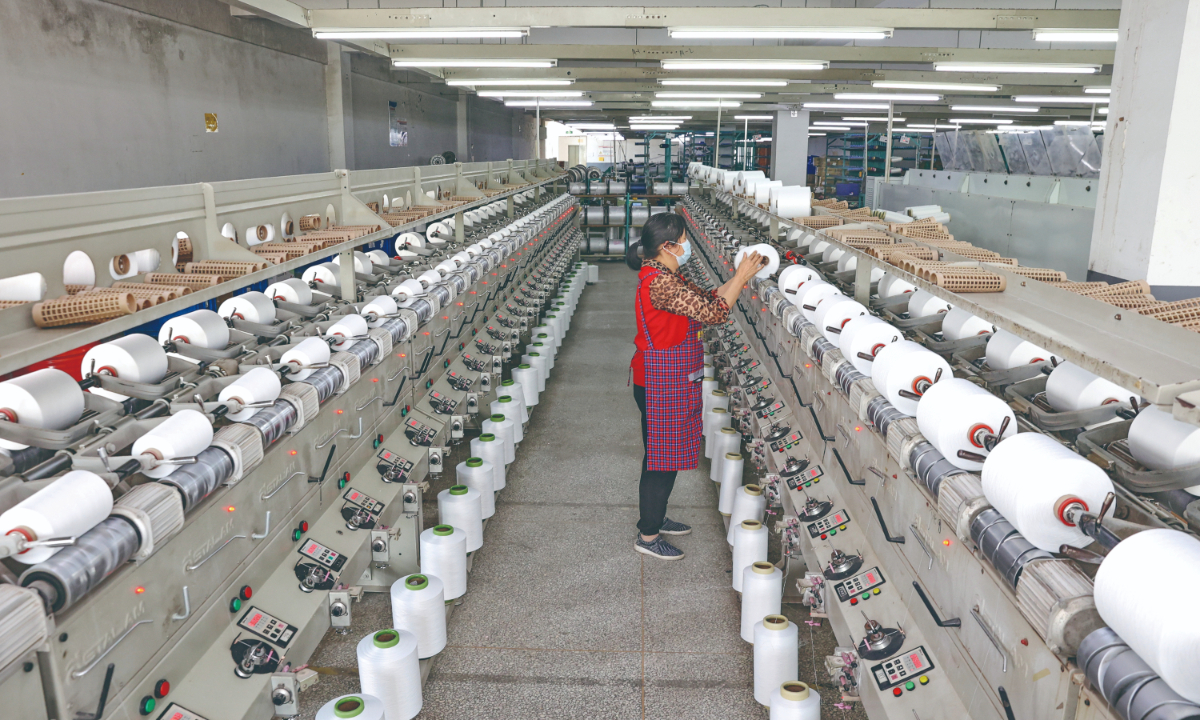
An employee works on a production line at a company manufacturing elastic fabric goods based in Nantong, East China’s Jiangsu Province on April 18, 2022. The company exports products to countries including Vietnam. Photo: cnsphoto
As Vietnam, an emerging manufacturing hub in Southeast Asia, recorded a stellar performance in foreign trade in the first quarter, the news has aroused wide discussions about the country's eating into orders that would have been placed to China - frequently referred to as the "World's Factory".
It is acknowledged that Vietnam is profiting from a shift in global supply chains amid the pandemic and its competition with China and other manufacturing nations has forged in a number of industries, yet it should also be seen that the economies of China and Vietnam are largely complementary.
More noticeably, it remains unlikely that a large number of multinationals will shift all their assembly lines out of China where the supply network has matured over the past decades, business groups and industry observers told the Global Times.
Vietnam's export-import revenue in the first quarter of this year was estimated to be $176.35 billion, up 14.37 percent year-on-year, of which $88.58 billion was from exports, rising 12.9 percent on a yearly basis. In March alone, export value reached some $34.06 billion, a jump of 45.5 percent month-on-month and 14.8 percent year-on-year, according to data from Vietnam's Ministry of Industry and Trade.
In 2021, manufacturing has accounted for 25 percent of Vietnam's economic output, and the country has become an important exporter of electronics, the volume of which has surpassed that of rice, coffee, and textile products.
Vietnam, as a leader in low-cost manufacturing and sourcing compared to other developing markets in the region, is expected to benefit greatly from the Regional Comprehensive Economic Partnership (RCEP), a mega regional free trade deal, said the World Bank.
Are orders shifting?There have been some narratives hyped by some Western media surrounding multinationals seeking to extract their industrial chain or supply chain out of China, hyping the "investor flight" theory, due to the country's stringent anti-Covid19 measures adopted in some major Chinese cities like Shanghai and Beijing to curb the rapid spread of Omicron variant.
Some orders that could have been placed to China have shifted to neighboring countries like Vietnam, Cambodia and Thailand where population structure is relatively young and labor is abundant and relatively inexpensive, aiding their power of building up exports.
According to an analysis report by CITIC Securities, the substitution effect of labor-intensive products represented by clothing, shoes and hats is more likely to occur, particularly in shipping those products to the US.
"We did have lost some orders, but we should be aware that it's a natural development of international industrial division of labor," Bai Ming, deputy director of the International Market Research Institute at the Chinese Academy of International Trade and Economic Cooperation, told the Global Times.
There are four stages in the international division of labor in the industrial chain: the first is the countries unable to enter the industrial chain, the second is the countries engaging in low-end manufacturing, the third is the countries trying to move into the high-end industrial manufacturing, while the fourth refers to dominance of the industrial chain, according to Bai.
"China is now at the third stage and striving to enter the fourth one, while Vietnamese factories are now mainly doing simple processing and assembling," he said.
"High-end industries now account for an increasing proportion of China's exports, and the order change will not have a significant impact on China's industrial power," Gu Xiaosong, dean of the ASEAN Research Institute of Hainan Tropical Ocean University, told the Global Times.
Complementary in natureCompared with the shifting orders, industrial transfer is deemed a bigger decision for the multinationals because the production cost is significant reduced. The shifting order from China to Vietnam usually do not involve the entire industry, but some specific links in the production process of the industry - mainly the links with low demand for the supply chain and high labor costs, experts said.
A worker with an electronics manufacturer based in South China's Guangdong Province told the Global Times that "some Chinese factories have also moved away from the Pearl River Delta region to Vietnam trying to explore business opportunities there by taking advantage of local cheap labor, but most of them had to come back due to Vietnam's lack of mature supply chains."
In contrast, China's southern manufacturing hub in the Delta has accumulated experiences for as many as 20-30 years in the ICT (Information and Communications Technology) and other related industries and the Delta has complete chain churning out the so-called upstream, middle and downstream components.
"The industrial chain between China and Vietnam is more of a complementary nature," Bai said.
China is Vietnam's largest trading partner, on which the Southeast Asian country relies for the sourcing of raw materials and equipment. Its imports from China rose 30 percent to reach $110 billion in 2021.
Vietnam's clothes and shoe factories are struggling to meet orders as supplies of raw materials from China are drying up amid the latter's fight against the pandemic, which has hurt the Southeast Asian nation's production and exports, the Bloomberg News reported on Friday, citing Pham Xuan Hong, chairman of the Ho Chi Minh City Garment, Textile Embroidery Knitting Association.




